The idea of training a blind dog may seem daunting at first, but I can assure you that it’s not much different from training a sighted dog. Sometimes, it’s easier as the dog has no visual distractions. However, training should always begin in a low-distraction environment (blind dogs can have excellent hearing and sense of smell – my blind dog misses nothing!).
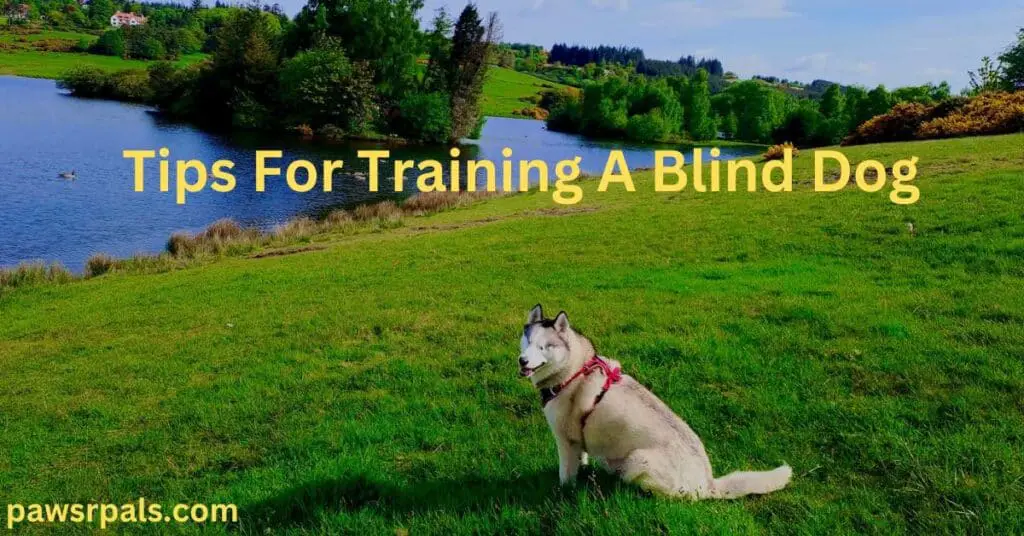
A blind dog can learn much the same things as a sighted dog. The only difference is that you use vocal cues rather than vocal cues and hand gestures. You can also incorporate touch cues, such as a touch to the lower back to associate with sitting or touching the left shoulder to go left.
Building Your Dogs Confidence
Playing is a real confidence booster for dogs. So, if your dog suddenly loses sight, relearning to play will help boost their confidence. Of course, a dog born blind will not know anything different, but it will still want and need to play.
A gentle hand and plenty of rewards (smelly treats work well) will encourage your dog’s confidence and eagerness to learn more. The main thing to remember is that your dog can no longer see your face or read your body language, so you must keep your tone light and happy when communicating with your dog. It will reassure your dog that you are pleased with them and that they are doing the right thing.
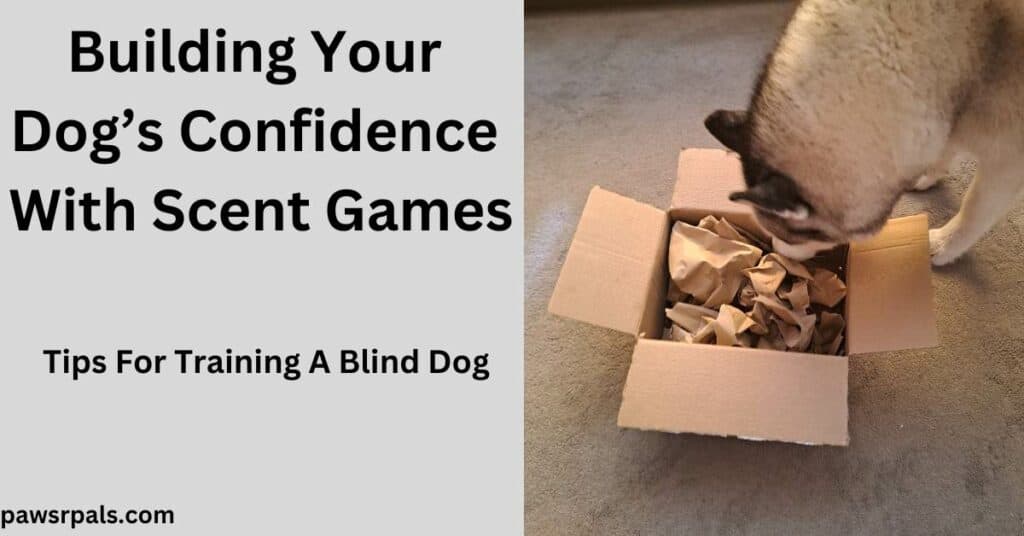
So the training is three-fold: to boost your dog’s confidence, re-establish the basic training essentials, and help them adapt to their new life without their sight.
Go At Your Dogs Pace
Every dog is different, just like us. They learn at their own pace; they will adjust to things in their own time. Like all training, going at your dog’s pace is essential. Train your dog where they are now, not where you want them to be. Rushing them before they are ready will be counter-productive.
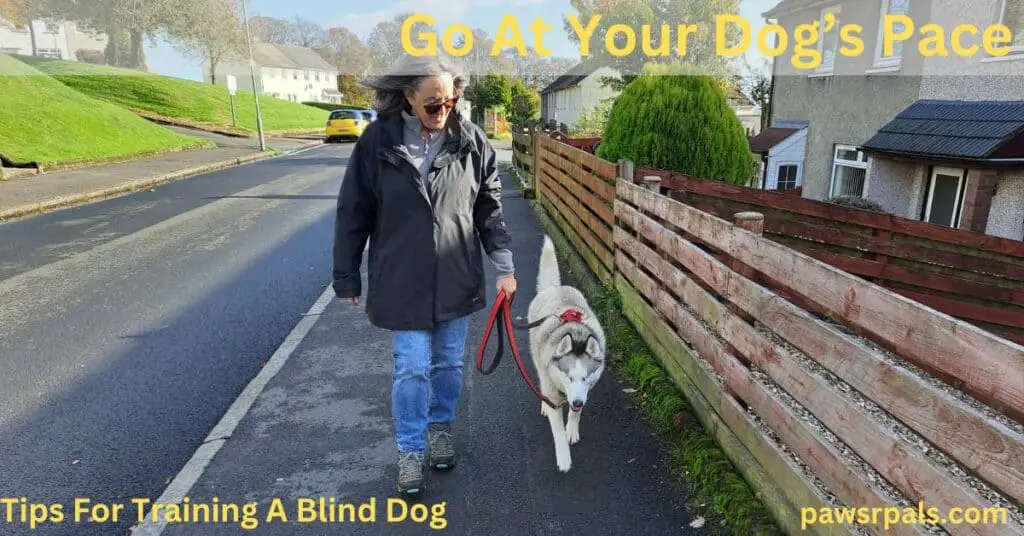
Always set your dog up for success, and always try to end on a positive note – even if that means going back a step to something your dog already knows what to do. It’s vital in training not to overwhelm your dog or let them become frustrated.
If your dog struggles to grasp something, return to the previous step or a cue they know well, and use praise and rewards. Doing this will also stop you from becoming frustrated and let you know it’s time for a break.
Train At A Slow Pace For Your Dog
It may be that your dog is feeling overwhelmed and scared by the sudden change in its circumstances. That’s fine and understandable. It may be that your dog is only happy in one room, which is also fine. Start some scent-tracking games with your dog in that room. This can be as simple as slowly trailing a strong-smelling treat along the floor and letting your dog follow the scent and eat the treat. Repeat as many times as it takes for your dog to enjoy the activity. This takes as long as it takes. There is no set timeline for your dog to adjust.
Don’t be disappointed or disheartened if your dog is only happy to play and do things in one room of your house. The main point is that your dog has somewhere that it feels happy and confident.
Do the games and basic training in that room. You can then try it in a different room and progress from there.
Reassurance and Confidence Building Is Most Important
When your dog is scared and overwhelmed, your focus will be on building your dog’s confidence. Nothing else. The training will wait. Your primary focus is helping your dog adjust and reassuring it that it’s still a good dog and nothing will hurt it. Plenty of comfort and reassurance. Try not to pick up your dog; instead, go down to its level, talk calmly, and gently pet it.
It may be that your dog is only happy to toilet outside and wants to go back inside where it feels safe. Again, this is understandable. Chat calmly to your dog while it toilets, and give it a few minutes to see if it wants to sniff its surroundings (sounds mundane, but if it does, this is progress).
Then, take your dog back inside, all the while chatting calmly. You don’t want to force your dog to be where it feels threatened or scared – you want to build its confidence.
If your dog is happy to explore inside the house, this is also progress. Dogs will use their nose, ears, and their paws. Different floor surfaces can help your dog differentiate between the different rooms in your house. Scents can also help your dog differentiate the rooms in your house.
Your Voice Is Now Your Dogs Eyes
When my dog went blind, it took me (and the rest of the family) time to adjust to using our voice for everything. Entering a room, I would announce myself. Going to touch Luna, announce yourself, and tell her you’re going to pet her. Putting down her food, telling her it’s dinner time, and taping her food bowl. The same with her water bowl.
Going upstairs, saying “up step” for every step, and going downstairs, “down step” for every step. Luna can still jump into and out of the car. I open the boot and tap on the boot’s entrance; she will lay her chin on the lip of the boot and then jump in. When she’s ready to jump out, I open the boot, tell her to wait, and stamp on the ground so she can hear how far the ground is to jump out. Luna is AMAZING!
When I put her harness on, I hold open the harness and say, “head in”, and she will put her head forward for me to put the harness on her. I trained her to do this by holding a treat at the bottom of the harness opening and using my other hand to hold the harness open.
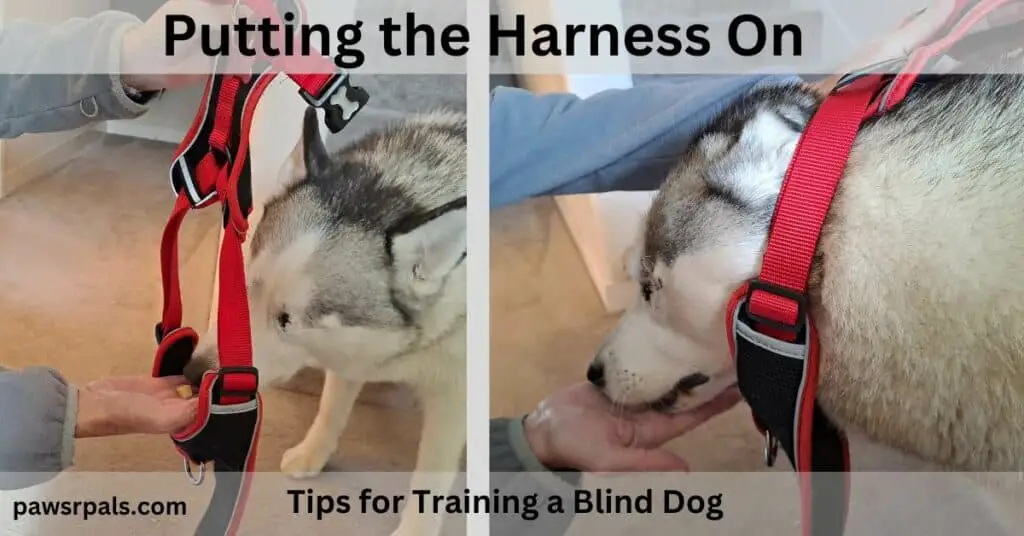
The easiest way to train directional cues is to announce what you’re doing as you’re doing it. For example, if you turn left, say something like “left left” as you perform the action. The same goes for turning right; I say, “Luna, right right”.
Doing the vocal cues inside allows you and your dog to get used to the verbal directions. These can all be done inside, then progress to outside when your dog is happy.
Start Training When Your Dog is Happy To
Once you are more confident in training your dog and your dog feels more confident in itself, you can progress in the training.
Progressing the training may be getting your dog to play in another room, then another room. It may be a while before your dog is happy to attempt to go for a walk outside. That is fine; going at your dog’s pace is so important.
The Importance of Giving Your Dog Time
I was worried that my dog would become scared and reactive. She didn’t, thank goodness, but we went at her pace. We did short walks initially and didn’t force her when she wanted to return home. We gave her the time she needed to adjust to her new condition. We also gave her the time to get used to having lots of verbal cues.
The critical part was letting her set the timeline for things. We didn’t rush her; we slowed our walks so she could sniff everything. Letting your dog sniff everything in their environment helps them create a scent map of their space.
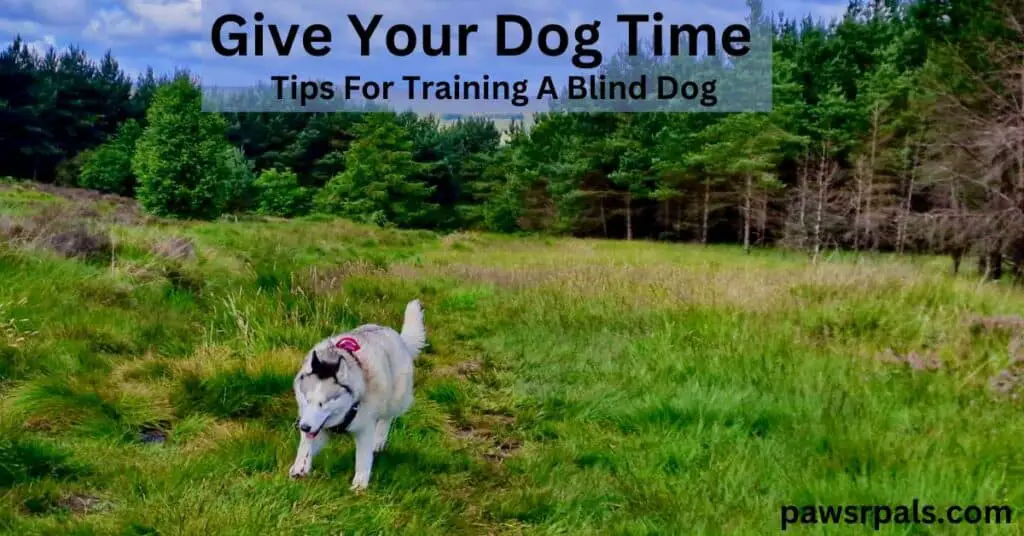
It seemed like no time at all that she wanted to go for her usual woodland walks and play with her friends. Her resilience was astounding; I’m still amazed by how well she has adapted. So many people don’t realise she is blind until they see that she has no eyes. Luna is confident and happy, and I think it’s because we went at her pace and didn’t rush her.
The extra training also has the added benefit of boosting your relationship with your dog and strengthening your bond. This is extremely important as your dog will listen and respond to you better when you are out and about with them.
The Blind Dog Halo
You can purchase a Halo for your dog, it’s an anti-collision ring that is attached to a harness, and stops the dog from bumping into things. You can get them on Amazon and Chewy.
My dog didn’t like it, she did much better using her nose and our verbal cues. However, I know some blind dogs find them reassuring. It’s trial and error.
I have written some articles on games to play with a blind dog and walking a blind dog.

Leave a Reply